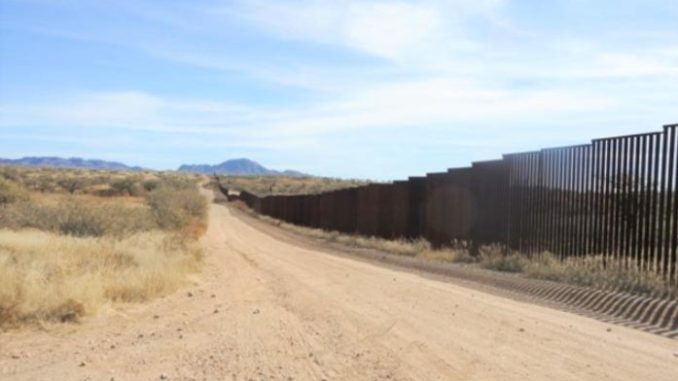
The following is testimony submitted by Arizona rancher James K. Chilton, Jr. to the House Committee on Homeland Security, Subcommittee on Border Security, Facilitation, and Operations, on February 27, 2020.
My name is Jim Chilton. I am a 5th generation rancher from Arivaca, Arizona. Arivaca is a small rural town approximately 55 miles southwest of Tucson, Arizona. Our ranch is adjacent to the town and extends south to the international border with Mexico. The ranch includes private property, State School Trust lands and three federal grazing permits in the Coronado National Forest. Our entire family, my wife of 56 years, our two sons and their children, my brother and his wonderful family, are blessed to be able to preserve our western ranching customs, culture, and heritage dating back to our pioneering ancestors who drove cattle from Texas to Arizona Territory in the late 1800’s. Our family has been in the cattle business in Arizona for about 130 years. We have a long-term view of the necessity to be excellent stewards of the grasslands we carefully manage. We are honored to have received various valued awards for resource conservation and wildlife stewardship.
Chilton Ranch and the International Border
Our family ranch is located adjacent to the United States/Mexico boundary in a corridor identified as among the most active for drug smuggling and human trafficking in the Nation. My comments generally relate specifically to the portion of the border south of our ranch extending from Nogales, AZ to Sasabe, AZ.
The following is a map of our beef-producing family ranch. Please notice that the southern end of the eastern part of the ranch is the international boundary for about five miles. Mexico is just across the fence. Our ranch boundary goes north and west bordering three other ranches. Crossers on the western side go through our neighbors’ grazing lands and then through our pastures.
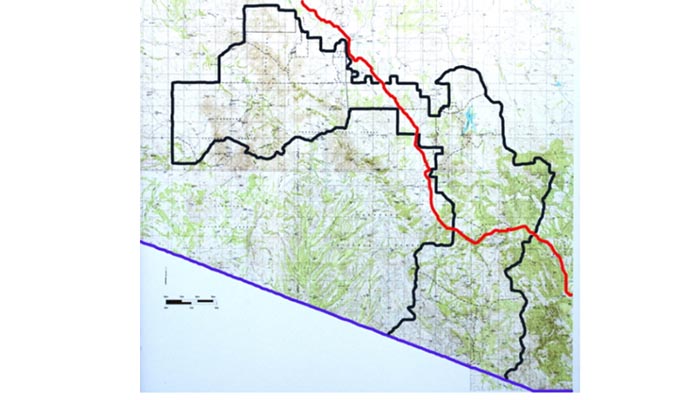
The following photo shows what the international boundary looks like on the southern end of our ranch. It is not signed or marked and mainly consists of a four-strand barbed wire cattle fence. Obviously, there is no wall and you would never know it was the international border by viewing it.
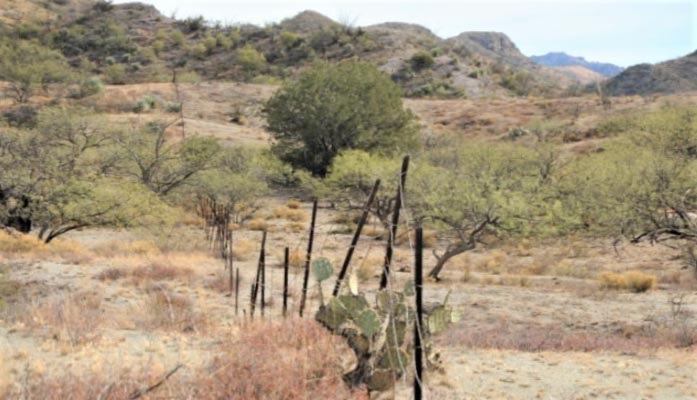
This is the U.S.-Mexico border. For approximately 25 miles, this is typical until it reaches the east end of the bollard-style modern wall built to protect the Buenos Aires National Wildlife Refuge. It is well known that the Mexican cartels use this 25-mile open door of rarely patrolled land with no border-paralleling road for their drug and people smuggling business.
The following photo shows the end of the wall about 2.5 miles west of Nogales Arizona and the point where the wall becomes an old pasture fence.

Jim Chilton: half in the U.S. and half in Mexico! Even an 80-year-young rancher can crawl under the current international border. As you can see, building an appropriate international border fence and road would be no challenge for American civil engineers. We laugh when we hear former officials say it’s such difficult terrain that, “no one in his right mind” would try it.
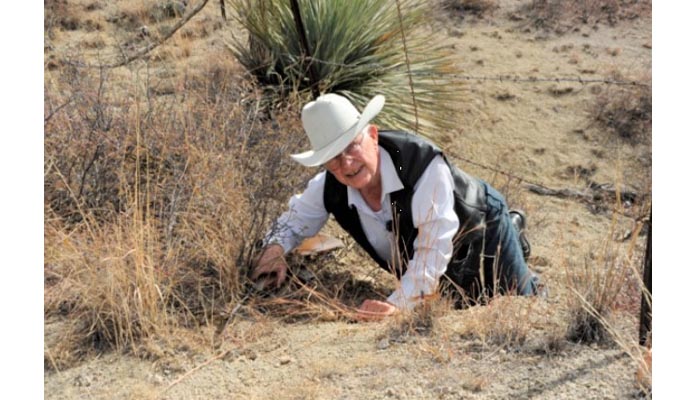
Border Patrol Strategy
The long-out-dated Border Patrol strategy is to focus on attempts at interdiction of rural area crossers ten, twenty, and over 100 miles inside the United States rather than at the international boundary. As a consequence, the federal government has de facto ceded hundreds of square miles of Arizona to the cartels. My neighbors and I strongly believe the Border Patrol must SECURE THE BORDER AT THE INTERNATIONAL BOUNDARY. The fact that drug packers, MS 13 gang members and deported criminals desiring to re-enter the nation walk through our neighbors’ ranches and our ranch is dangerous for us and for our neighbors. We believe every nation has the sovereign right to secure and control its border and our nation is not succeeding in exercising that right.
We want to emphasize that we support and deeply appreciate the Border Patrol. The agents are polite, well trained and there is a sincere effort by the Sector Commander, his top officials and Tucson Station Patrol Agent in Charge to listen to and try to address ranchers’ border issues. We also appreciate many of the current Border Patrol efforts, including checkpoints, drug-sniffing dogs, and other strategies which certainly interdict highway traffic. We believe, however, these tactics are woefully insufficient to actually stem the tide of cartel operations flooding cross-country routes through border ranchlands of Arizona like ours.
Why is the entire Tucson Station of the Border Patrol with approximately 650 officers operating from a location 80 miles and about three hours from the international boundary at the southern end of our ranch? The Tucson Station has about 24 miles of the international boundary to secure, or 27 agents per mile. Currently, the Tucson Sector personnel report to work in downtown Tucson, check out weapons and vehicles and then drive approximately three hours to reach the border on our ranch. The waste of time and the high cost of each officer traveling to and from the border in his or her individual Border Patrol vehicle are outrageous.

National security demands that drug traffickers, terrorists, and previously deported people be prevented from entering the United States at the border. Asylum seekers and work seekers need to cross at the legal Ports of Entry. Currently, on our ranch all of the above often travel cross-country 10 to 20 miles before the Border Patrol even attempts to apprehend them. Why? Because the Border Patrol is not based at the border; old, slow, dirt roads have not been improved to the ranchland borders, and communications fail in the borderlands. We can work all day on the ranch and not encounter Border Patrol anywhere near the border.
Why is there a huge Border Patrol station located in Casa Grande when the city is located approximately 130 miles from the international boundary? Certainly we are pleased that thousands of cartel drug packers and cartel-led border crossers are arrested in Pinal County every year. However, we question the current strategy that lets these undocumented persons walk through our ranch or through the Tohono O’odham Reservation to the west of us to disperse so far into Arizona. This strategy allows, we believe, more than half of the crossers to escape detection. This capture percent is even deemed too generous by Border Patrol officers with whom we speak “off the record.” Would a football team ever win a game if, on defense, the team lined up ten yards behind the line of scrimmage?
Need to Secure the Border at the Border
Wouldn’t it make sense to have a Wall TO SECURE THE BORDER AT THE BORDER where linear miles can be effectively patrolled rather than leaving hundreds of square miles of southern Arizona crossed by a web of cartel trails and routes? Of course, square miles are more difficult and costly to patrol than linear miles!! Wouldn’t it be enormously more effective to have patrolled roads along a bollard-style wall (deemed most appropriate by the Border Patrol) together with 21st century communications, cameras and sensors plus 24/7 actual presence of the Border Patrol? Isn’t it called the “Border Patrol” and not the “Interior Patrol? Wouldn’t their presence at the border be a much greater deterrent to cartel offensives than the current backfield game plan?
There are tremendous advantages to closing the gap in the wall between Nogales and Sasabe and then continuing construction to the east end of the wall at Yuma. To achieve reasonable border control, and ensure that rural Arizona is not the “sacrificed route,” effective structures and strategies must also be implemented all the way across Arizona’s borderlands. Most importantly, the bollard-style fence must be conscientiously patrolled and must include forward operation bases, roads paralleling the boundary and surveillance technology. Congress needs to appropriate necessary funds to allow for the completion of the wall, roads and forward operation bases.
A retiring high-level Border Patrol official sat in our living room with all our neighbor ranchers and stated that “electronic surveillance alone only tells me what I missed.” He added, “…we can not respond in actionable time.” Any policy of reliance upon information on which no effective deterrent action can be taken is virtually useless. That perspective allows—even encourages and abets–the current abuse, abandonment, rape, mutilation and murder of would-be workers who are told by cartel operatives that this is the best route. They pay, suffer and are often used as decoys while the drug loads are routed around a different canyon or trail.
Advantages of Securing the Border at the Border
The following are some of the advantages to completing an effective, bollard-style fence with adequate patrolling and appropriate technology and forward operating bases:
First, U. S.Government Accountability Office and Judicial Watch have reported that people crossing the open border sections have been arrested from terrorist-sponsoring countries. How many crossers from terrorist nations actually got through and where are they now? How many successful crossers from the Middle East are connected to ISIS?
Second, it is outrageous that Mexican cartel scouts with satellite phones and other military-grade equipment are free to occupy strategically-selected hilltops for dozens of miles inside Arizona including on our ranch. As a consequence, the cartel scouts know where the Border Patrol is at all times so they can carefully guide drug packers–and people whom know they are not eligible for asylum–through the wooded canyons and along hundreds of smuggler trails on our ranches. Border Patrol officers apprehend fewer than half of the foreign migrants and smugglers according to national Border Patrol Council Vice President, Art del Cueto. Interdiction at the border would stop the occupation of Arizona border ranchlands by these cartel operatives.
Third, environmental costs of the current failure to effectively stop the flood of crossers are well-documented. Much of the unfenced minimally-patrolled Arizona border area includes national forests, conservation areas, monuments and wildernesses. These are exactly the open routes most used by the cartel-led operations. The Border Patrol reported at a meeting we attended that undocumented crossers have left a reported average of 8.5 pounds of trash apiece on these lands. It is estimated that over 25,000 tons of garbage have been dropped by crossers in the Tucson Sector alone since 1992. Just since June 2007 until March 2019 another 463,000 pounds of trash was collected along the Arizona border according to the Arizona Department of Environmental Quality’s Border Trash report. Additionally, just as of 2010, the Organ Pipe Cactus National Monument documented approximately 2,553 miles of wildcat roads and trails just on their portion of the border with Mexico.
Fourth, there are intolerable human tragedies and abuses faced by work-seeking border crossers, especially women. Work-seekers currently have no feasible option but to cross in the hands of the cartel. It is reported that over 2,500 border crossers have died just in the Tucson Border Patrol Sector since 1990. Horrific human tragedies could be avoided by securing the border at the border and implementing a feasible, simplified, e-verifiable worker documentation program to provide a legal and safe alternative for needed workers.
Fifth, we have been burglarized twice by south-bound drug packers who, after depositing their drug load at GPS sites or safe houses, stole laptops, cameras, firearms, including historic pieces, and other valuable items they steal to carry on their return to Mexico. This is a typical situation for those of us near the border. Ranchers in the border area cannot leave their houses unguarded even for a few hours since their homes and ranch buildings are often broken into if someone is not on guard duty. It can be hours before law enforcement can respond to rural calls.
Sixth, Arizona borderland residents, ranchers and farmers have suffered hundreds of millions of dollars in property damage and personal loss due to major forest fires set intentionally or accidentally by illegal crossers. The human and property costs of these fires, like the Monument Fire, the Murphy Complex Fire, Chiricahua Fire and the Horseshoe Fires must also be figured into the cost of NOT securing the border at the border. We have estimated that U. S. Forest Service costs in one year to fight fires caused by border crossers just in Arizona borderlands were about $600 million.
Seventh, another cost of inaction never calculated by those who decry the “expense” of effective wall and border protection, is the financial and emotional burden placed on ranchers living in Arizona border counties. In addition to suffering losses from home invasions and burglaries, we shell out thousands of dollars each year in constant fence and water line repair and we and our cowboys all work armed. The additional, unquantifiable emotional cost to our families is summarized by noting we are all very much aware of what happened to Sue Krentz’s husband Rob when he went out to check his ranch waters and was killed (including his dog) by a drug packer who then escaped into Mexico.
Eighth, we have heard just this week that the Border Patrol has picked up Chinese crossers coming through our area. The possibility of increasing numbers of undocumented persons, specifically escaping areas where they may have been exposed to coronavirus, is a new concern.
Finally, what percent of the opioids flooding this country comes through rural trails? We know from our hidden cameras that marijuana packs were the dominant VISIBLE drug in prior years, but we have heard that much higher value, lighter-to-pack fentanyl, heroin, cocaine and other drugs are showing up in rural apprehensions now that high tech surveillance is more effective at the Ports of Entry. What is the cost to America of increases in cartel use of open routes like the ones in our area for hard drug importation?
To effectively secure the border, the Border Patrol needs to build the wall and be able to construct or improve roads, build helicopter pads and place forward operating bases at or very near to the border. Construction needs to be freed of the impediments created by federal environmental laws which chiefly benefit the cartels, not the wildlife, in Arizona borderlands. Every day that the U.S. border remains unsecured is another opportunity to allow all of the negative consequences that are so real to borderland ranchers and to this Nation at the present.
The Wall, Humans and Wildlife
Border Patrol Agents apprehended fewer than half of the foreign migrants and smugglers according to national Border Patrol Council Vice President, Art del Cueto. Opponents of effective border control in rural areas advocate prioritizing cross-border wildlife-roaming over interdiction of cartel operatives. Essentially, their perspective is that the human, environmental and social cost of the illegal drug and people traffic is less of a concern than the creation of any impediment to the free passage of animals and wildlife connectivity with Mexico. This route through our portion of southern Arizona is today’s Ho Chi Minh Trail.
In spite of the environmental, financial and security impacts on our ranch, we have taken action to help prevent deaths of any of the crossers. I have installed safe-water drinking fountains on 29 sites where I have my 22 wells and water lines. We don’t want anyone to die of thirst.
Wildlife genetic diversity on both sides of the border can be achieved along with border security by legally transporting animals as scientifically deemed essential. Large mammals can be transported with safe capture to promote genetic diversity while birds can fly over and small animals and reptiles can easily slip through the bollard-style wall. In addition, American engineers can create wildlife friendly, effectively managed passages at some parts of the wall to facilitate wildlife connectivity with Mexico. Keep in mind the irony that the Buenos Aires National Wildlife Refuge sought and obtained a bollard-style border fence and border-paralleling road because they did not want the danger, the wildcat roads, the trash and the fires nor “Wild Life Connectivity” on their border!! We neighbor them and we get all of the above re-routed onto our ranches! First, tear down the bollard-style wall with its patrol road on our Refuge neighbor—then talk to us about “connectivity.”
The following photograph shows the U. S. Fish and Wildlife Service bollard-style wall and adjacent patrol road at the Buenos Aires National Wildlife Refuge along its border with Mexico—it adjoins the old 4-strand wire fence on our neighbor’s ranch. The refuge did not prioritize a concern for wildlife connectivity.
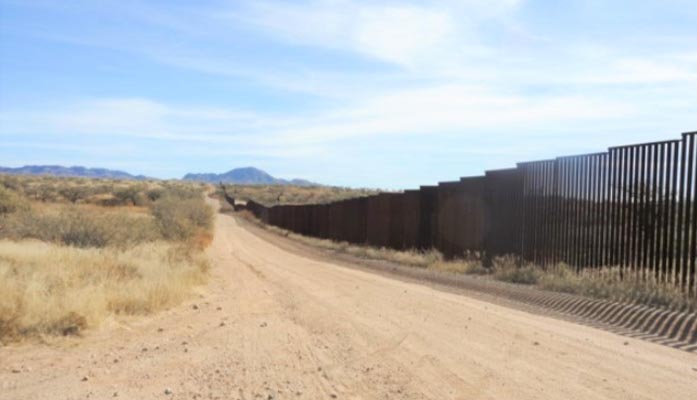
How can it be acceptable that residents of rural southern Arizona are not accorded the same protections provided to residents of the rest of the country? Our homes and ranches and our daily environment is treated as a no-man’s land exposed, by strategic federal choice, to armed foreign trespassers. The current strategy of minimal Border Patrol presence along large segments of the rural Arizona border leaves us unprotected and assures the continued flow of drugs, the abuse of migrants, and the trashing of border lands. None of this, including wildcat roads, trash, wild fires, human trampling, conflicts between drug packers and gang rip crews, could possibly be deemed favorable for wildlife. Persons opposing interdiction of drugs and undocumented crossers loudly cite the costs of securing the border and omit all mention of the human, environmental and security costs of NOT securing it. END OF TESTIMONY
Related articles:
Rancher Jim Chilton Has To Police The Border Himself
A Petition from Southern Arizona Ranchers on Border Security

